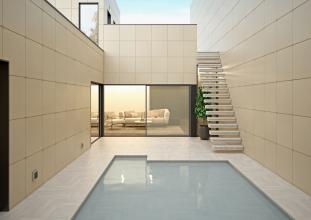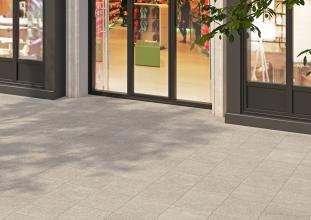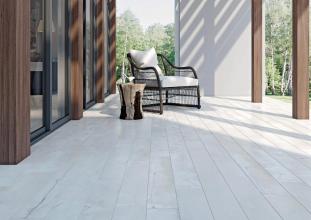A sphere of the gres application is very wide, and it can be used not only for finishing private houses and for apartments. Due to its high abrasion resistance, this material has found its place in the facing of technical, public and industrial facilities with regular and high traffic.
Gres has amazingly high durability and abrasion resistance, so it is installed in airports, railway stations, stadiums, shopping centers, car washes and metro stations. However, not all types of tiles are suitable for this. The purpose of a particular trade item is determined by the thickness of the material, as well as the method of its surface processing.
Tile with a matt surface is considered the most resistant to external influences among the different types of gres
Such ceramic tile has a slightly rough surface and almost does not need further processing after leaving the firing kiln. This gres type inferior, from the position of aesthetics, to other polished ceramic products, but its advantage is that the matt gres can hardly be scratched.
The surface hardness of the gres has 8-9 points according to the Moh’s scale
To carry out the hardness of the gres, as well as any other material, is easy with the help of the universal 10-point scale of Moh’s. It is used for testing the product’s resistance to the mechanical damages (scratches). The scale is a rating system from 1 to 10 points, where each point corresponds to a standard material – a natural mineral. At the same time, a harder standard can scratch softer.
The hardest mineral with 10 points on the Moh’s scale is a diamond that can cut glass. The softest standard is talc (1 point), which is easy to scratch with a fingernail. One or other standard scratches the material surface for testing its hardness. If there is a visible damage or a mark on it, this means that the product is softer than the standard. Matt gres has 8-9 points on the Moh’s scale, which means that its hardness is set between topaz and corundum, which, like a gres, can only be processed with a diamond tool. This high hardness is indicated by the fact that the gres is not damaged by quartz or sand, which has a 7 points hardness. Exactly sand is the most common abrasive material that is also a part of street mud.
It is understandable that gres cannot be scratched by metal, for example, with a kitchen knife, and this artificial stone is a wonderful material for countertops. Besides, for comparison, the marble according to the Moh’s scale does not have more than 4 points.
Class of the abrasion resistance of glazed gres – PEI II-IV
To improve the aesthetic characteristics, the surface of the gres needs an extra processing. It can be polished to a glossy luster or covered with a glaze before firing, in order to get a glazed tile at the outlet. The hardness of the polished gres is inferior to the matt tile, and it is much less used for flooring. Nevertheless, the usage of glazed gres is widely spread.
The deep abrasion of glazed gres is not measured according to the Moh’s scale, but according to a special PEI technique, which was created by the American Institute of Enamel and Ceramics (Porcelain Enamel Institute). Unlike the Moh’s standard scale, the classification of PEI is a practical testing system, which does not describe the surface hardness, but resistance to the abrasion. It was made to systematize ceramic tiles according to its intended use.
According to the PEI classification, all glazed ceramic tiles, including gres, are divided according to the results of tests, into 6 classes, which are marked from PEI 0 to PEI V. Tile testing is done by influencing the surface of the disk with abrasive material (corundum). The degree of abrasion of the tile is determined visually after a certain number of grinding wheel turns.
The PEI class determines what a tile is suitable for
· The PEI class 0 does not actually use for flooring.
· The PEI class I is applied on the floor in bathrooms and bedrooms, where there is no entrance from the street, and it is possible being barefoot or in soft shoes.
· The PEI class II is used for flooring in living areas, except kitchens and hallways, where it is possible to walk in usual shoes, but not in heels and also where there is no entrance from the street because abrasive contamination can damage the surface.
· The PEI class III is laid on the floor in any living areas with medium intensity traffic (including small offices and small hotels) where it is possible to walk in usual shoes, but not in heels. A minimum amount of abrasive contaminants is possible and there is no entrance from the street.
· The PEI class IV has high abrasion resistance, which includes gres, is used for flooring in living and public areas (including offices, hotels, restaurants, shops, etc.) with intense traffic and a small amount of abrasive contaminants. Entrance from the street should be equipped with a system of shoe cleaning.
· The PEI class V has the highest abrasion resistance and is designed for areas with very intense traffic, more pollution-prone (airports, train stations, shopping malls, etc.).
How to choose the gres thickness
Except the hardness and abrasion resistance characteristics, it is important to assess correctly the gres hardness, which depends on the thickness of the floor tile.
· For use in living areas where the risk of falling heavy objects is minimal and there is no massive legged furniture (for example, in the bathroom or in the lavatory), suitable a tile of 8-10 mm thick.
· Universal ceramic tile for facing the floor of any living and small public areas has a thickness of 9-12 mm.
· The floor tile for technical and intensive public use should be at least 9 mm thick, but preferably 12 mm or more.



